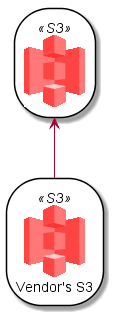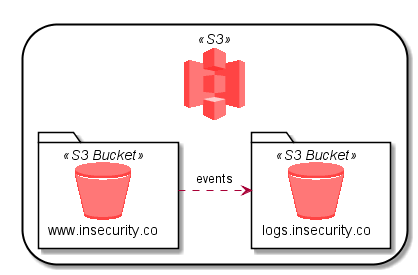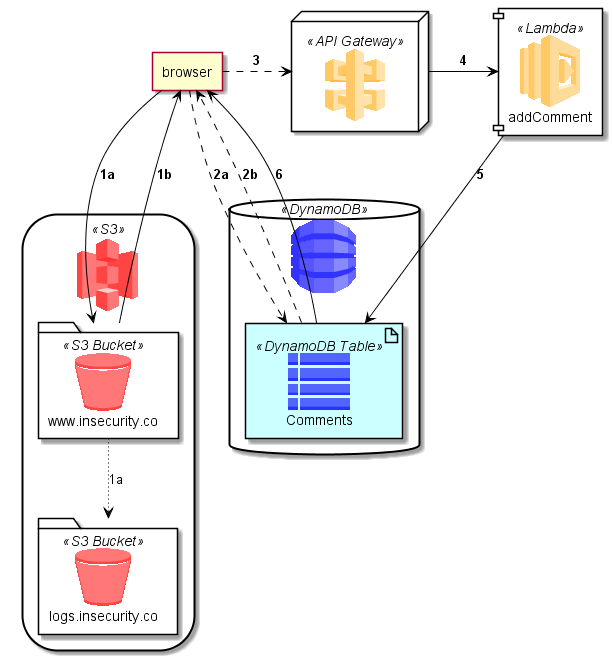PlantUML sprites, macros, stereotypes, and other goodies for creating PlantUML diagrams with AWS components.
At a minimum, you'll find that AWS-PlantUML will have a high-quality sprite for any of the AWS icons in the AWS Simple Icons package.
In many cases, you'll find that convenience macros are defined for AWS components and services, to quickly add stylized elements to your PlantUML component diagrams.
At the top of your PlantUML .puml file, first include the the common.puml file found in the root of this repo.
If you want to tweak the basic representation of AWS-PlantUML entities, or you don't want to rely on an internet connection, you can just download common.puml to your local machine and add it after the @startuml with:
!include path/to/common.puml
Otherwise, you can link directly to the file in this repo with:
!includeurl https://raw.githubusercontent.com/milo-minderbinder/AWS-PlantUML/master/common.puml
After the common.puml is added, you can then add any additional .puml files from AWS-PlantUML to import the specific sprites, macros, and other definitions you need.
!includeurl https://raw.githubusercontent.com/milo-minderbinder/AWS-PlantUML/master/common.puml
!includeurl https://raw.githubusercontent.com/milo-minderbinder/AWS-PlantUML/master/StorageContentDelivery/S3/StorageContentDelivery_AmazonS3_Bucket.puml
!includeurl https://raw.githubusercontent.com/milo-minderbinder/AWS-PlantUML/master/StorageContentDelivery/S3/StorageContentDelivery_AmazonS3.puml
To add components with macro definitions, like S3 and S3 Buckets, typically these macros will take an alias as the first parameter, and a label as an optional second parameter:
AWS_S3(s3_internal)
AWS_S3(s3_partner,Vendor's S3)
s3_internal <-- s3_partner
You can also nest components inside others using enclosures:
AWS_S3(s3) {
S3_BUCKET(site,www.insecurity.co)
S3_BUCKET(logs,logs.insecurity.co)
}
site .r.> logs : events
Before you know it, you'll be creating nice, clean diagrams for your AWS applications:
@startuml
!define AWS_PLANTUML https://raw.githubusercontent.com/milo-minderbinder/AWS-PlantUML/master
!includeurl AWS_PLANTUML/common.puml
!includeurl AWS_PLANTUML/StorageContentDelivery/S3/StorageContentDelivery_AmazonS3_Bucket.puml
!includeurl AWS_PLANTUML/StorageContentDelivery/S3/StorageContentDelivery_AmazonS3.puml
!includeurl AWS_PLANTUML/Compute/Lambda/Compute_Lambda.puml
!includeurl AWS_PLANTUML/Database/DynamoDB/Database_DynamoDB.puml
!includeurl AWS_PLANTUML/Database/DynamoDB/Database_DynamoDB_Table.puml
!includeurl AWS_PLANTUML/ApplicationServices/APIGateway/ApplicationServices_APIGateway.puml
skinparam componentArrowColor Black
agent browser
AWS_S3(s3) {
S3_BUCKET(site,www.insecurity.co)
S3_BUCKET(logs,logs.insecurity.co)
}
API_GATEWAY(api)
LAMBDA_FUNCTION(lambda,addComment)
DYNAMODB(dynamo) {
DYNAMODB_TABLE(comments,Comments)
}
browser --> site :**1a**
site ~~> logs :1a
site --> browser :**1b**
browser ..> comments :**2a**
comments ..> browser :**2b**
browser .r.> api :**3**
api -r-> lambda :**4**
lambda --> comments :**5**
comments --> browser :**6**
@enduml
Enjoy!


